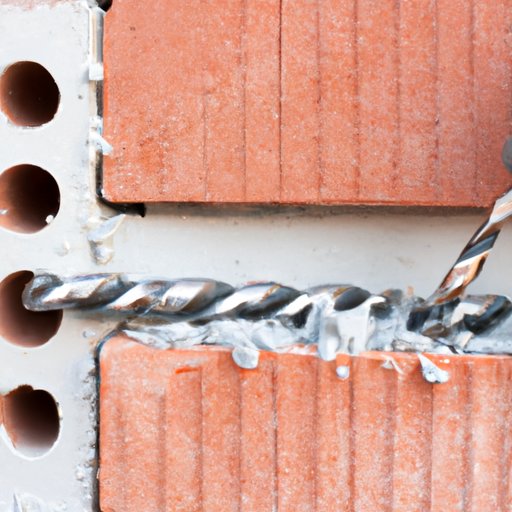Introduction
Drilling into brick can be a challenge, especially for those who have never attempted it before. However, with the right tools and techniques, it is entirely possible to drill safely and effectively into brick without causing damage or injury. This article aims to provide a step-by-step guide for homeowners who need to drill into brick for various projects around the house.
Step-by-Step Guide to Drilling into Brick
Before you begin drilling into brick, you will need to gather the following equipment: a drill, a power source for the drill, the appropriate drill bits, a hammer, a masonry nail, masking tape, and a dust collector. Choosing the right drill bit is vital: a carbide-tipped masonry bit is the best choice for brick material, while cobalt or titanium bits may be suitable for softer brick types.
Start by marking the spot where you want to drill with masking tape. Use the masonry nail and hammer to create a pilot hole in the center of the marked spot. This will help guide the tip of the drill bit when you begin drilling. Next, attach the carbide-tipped masonry bit to your drill and place the tip of the bit into the pilot hole you created. Hold the drill steady and apply slow and steady pressure as you drill into the brick. Use a dust collector or vacuum to collect debris as you work.
Be sure to take safety precautions during the drilling process. Wear protective gear such as safety glasses, a dust mask, and earplugs, and work in a well-ventilated area. Keep your hands away from the moving parts of the drill, and avoid wearing loose clothing or jewelry that could get caught in the drill or get snagged on the wall.
Types of Drills You Can Use to Drill into Brick
There are several types of drills that can be used for drilling into brick, including hammer drills, rotary hammers, and cordless drills. Hammer drills are a popular choice, as they hammer the bit into the material while spinning it, allowing for more efficient drilling. Rotary hammers, on the other hand, use a piston mechanism to hammer and spin the bit, making them more suitable for heavy-duty projects. Cordless drills are less powerful but can be used for smaller jobs, such as hanging pictures or shelves. Consider the scope and scale of your project when choosing the best type of drill for your needs.
Common Mistakes to Avoid When Drilling into Brick
There are several common mistakes people make when drilling into brick, including using the wrong type of drill bit, applying too much pressure, and not drilling perpendicular to the wall. Using the wrong type of bit can cause frustration and damage to the drill and the wall. Applying too much pressure can cause the bit to overheat, which can lead to damage or injury. Drilling at an angle can also cause damage to the surrounding brick and the drill bit.
To avoid these mistakes, choose the correct drill bit, use a firm but steady hand when drilling, and be sure to keep the drill bit perpendicular to the wall at all times. It is also essential to use the correct speed and power setting on your drill, as this can help prevent overheating and damage to the drill and the wall.
Tips for Drilling into Brick Without Damaging It
If you need to drill into brick without causing any damage, there are a few tips and tricks to consider. First, use masking tape to mark the area where you will be drilling. This will help you stay on track and prevent any unwanted drilling. Second, use a dust collector to collect debris as you work. This will help keep your work area clean and make it easier to see what you’re doing. Finally, be sure to drill slowly and carefully, applying steady pressure and keeping your drill bit perpendicular to the wall.
Safety Precautions When Drilling into Brick
It is essential to take safety precautions when drilling into brick, as this can be a hazardous activity. Be sure to wear protective gear such as safety glasses, a dust mask, and earplugs, and work in a well-ventilated area. Keep your hands away from the moving parts of the drill, and avoid wearing loose clothing or jewelry that could get caught in the drill or get snagged on the wall. Always be mindful of your surroundings and take breaks if you feel fatigued or overwhelmed.
What to Do If Your Drill Bit Gets Stuck in Brick
If your drill bit gets stuck in the brick, there are a few things you can do to remove it. First, try using pliers to twist and pull the bit out of the wall. If this doesn’t work, you can try using a screwdriver to gently pry the bit loose. If neither of these methods is successful, you may need to purchase a drill bit extractor tool, which is specially designed to remove stuck bits from walls.
Conclusion
Drilling into brick can be a challenging task, but with the right equipment and techniques, it is entirely possible to drill safely and efficiently. Remember to take safety precautions, choose the right drill bit, and use a firm but gentle hand when drilling. Avoid common mistakes such as applying too much pressure or drilling at an angle, and be sure to follow the tips and tricks outlined in this article.
